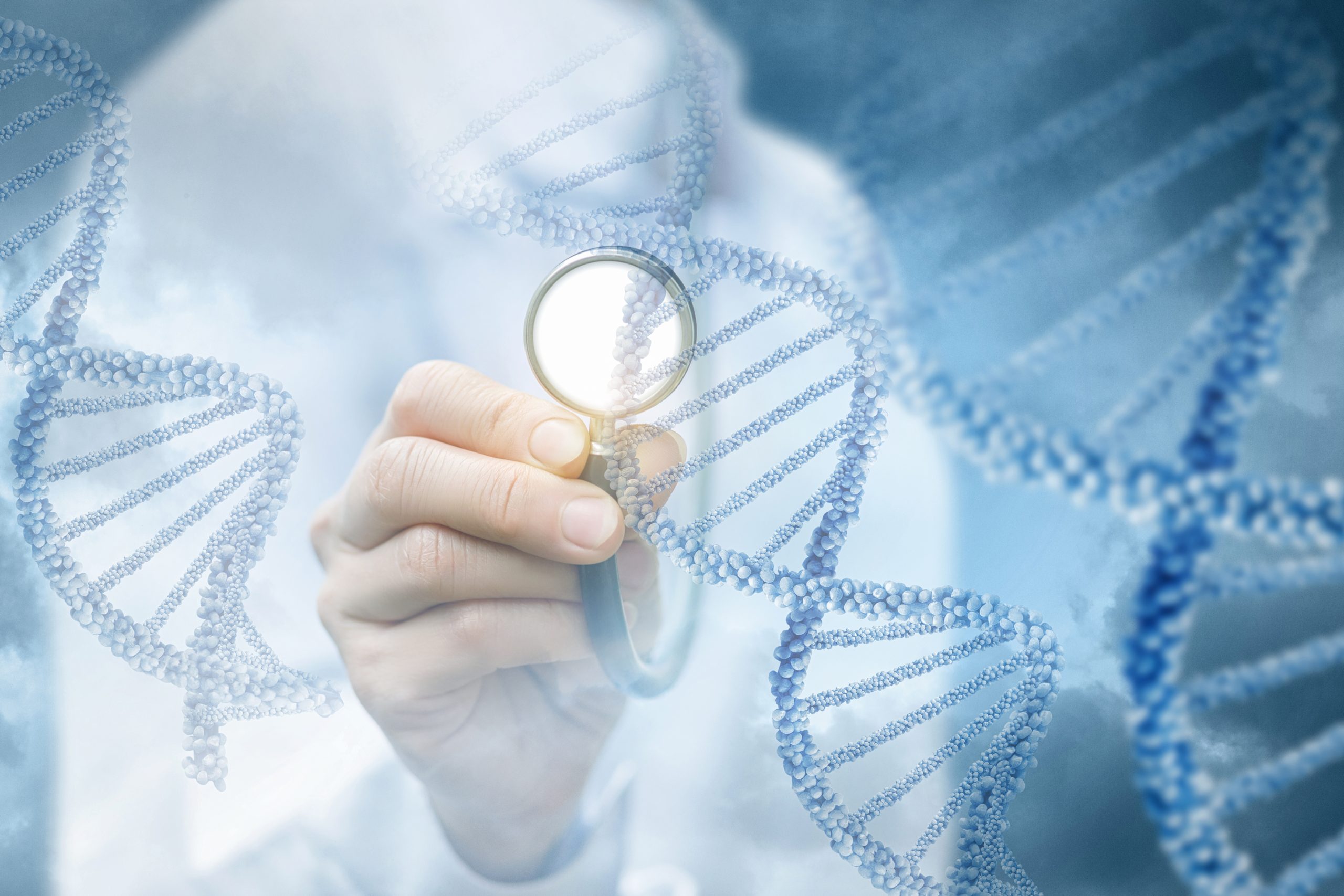Infertility very often has a genetic basis, and thus requires consultation with a genetic doctor. As a specialist in hereditary diseases – based on the results of DNA tests and a thorough interview with the couple – he can determine whether the cause of problems with conceiving a child can really be in genetics.

Genetically determined infertility – it manifests differently in women and men
In the case of women, fertility disorders may be attributed to, among others repeated miscarriages, primary or secondary amenorrhea, endocrine disorder, abnormal reproductive organs or lack of tertiary sexual characteristics (no breast, body hair, no female figure). The cause of female infertility may also be endometriosis or premature ovarian failure.
It was once thought that infertility affects only women. Today we know that this is not true. The share of both sexes in fertility disorders is more or less evenly distributed and amounts to approx. 40% for women and 40% for men. 20% is the so-called idiopathic infertility, i.e. one whose cause cannot be determined.
In practice, this means that men, just like women, may have problems conceiving a child. An important symptom of male infertility are impaired sperm parameters. Most often these irregularities include:
- oligospermia (or oligozoospermia) – a decrease in the number of spermatozoa (less than 20 million / ml) in the ejaculate,
- astenospermia (also known as asthenozoospermia) – abnormal motility of the spermatozoa found in the ejaculate,
- teratospermia (or teratozoospermia), an increased amount of sperm in an ejaculate with an abnormal morphological structure.
- azoospermia, i.e. complete absence of sperm in the semen, which is the absolute cause of male infertility
Azoospermia is often… genetic
We already know that azoospermia is associated with a complete lack of spermatozoa in the ejaculate. It can result from both vas occlusion, or the pathways through which male germ cells (sperm) are drained from the testicles, as well as from abnormalities in the production of these cells. The condition in which the vas deferens are obstructed is called obstructive azoospermia. In the second case, we are talking about nonobstructive azoospermia.
Microdeletions and mutations
The production of spermatozoa may be disturbed due to the microdeletion (a very small chromosome defect) of the AZF region on the Y chromosome. This chromosome contains genes responsible for the production of proteins that participate in the process of spermatogenesis (formation of spermatozoa). The presence of changes in this region leads to disturbances in this process and sperm are not produced as they should.
Obstructive azoospermia is responsible, among others, for a mutation in the CFTR gene. Yes, the same that leads to the development of cystic fibrosis. It is a genetic disease that we associate mainly with respiratory symptoms, although in reality it causes much more health problems.
Cystic fibrosis is characterized by the presence of thick, sticky mucus in all organs containing mucous glands. Excess secretions accumulate, among others in the cervix, preventing sperm from moving freely. The mucus is also blocked by male vas deferens, which make them obstructed. It also happens that due to mutations in the CFTR gene in men there is a congenital bilateral or unilateral lack of vas deferens.
The occurrence of fertility disorders is the basis for a karyotype test
Karyotype study is a cytogenetic study that allows you to look closely at all chromosomes in which human cells are equipped. We can assess their number and construction. Based on the result of the karyotype test, the geneticist is able to identify changes in the chromosomes that may be responsible for the infertility of the examined couple. For example, male Klinefelter syndrome or Turner syndrome present only in women.
Klinefelter syndrome
This disorder is associated with the presence of at least one additional X chromosome in the male karyotype. At least one, because there may be more of these X’s. Excess genetic material in cells will unfortunately be reflected in the appearance of the body and the functioning of the male body. Patients with Klinefelter syndrome often take on a more feminine silhouette, have poorly developed muscles and smaller testicles compared to healthy men. In addition to changes in the external appearance, males with Klinefelter syndrome often have a delayed speech development and intellectual disability.
Turner syndrome
In the case of Turner syndrome, in turn, there is a partial or complete lack of X chromosome in the girl’s karyotype. Patients primarily have short stature and fertility disorders (infertility or infertility). In the course of the Tuner syndrome, abnormal development of reproductive organs often occurs. The ovaries do not function as they should – in their place there is often the presence of connective tissue bands about 2-3 cm long. Turner syndrome also manifests itself in the external appearance of the sick girl. In addition to low growth, you can include observe valgus crookedness, lymphoedema, short, fin neck and dysmorphic features of the face – including diagonal wrinkle, wide eye spacing, and drooping eyelids. These are obviously just some of the very many symptoms of Turner syndrome.
Diagnostics of infertility – what is the role of genetics in all this?
In the case of couples struggling with the problem of infertility, the geneticist should primarily assess their chances of having healthy offspring. It usually does this on the basis of an in-depth medical history and the results of tests provided by patients or self-ordered. Of course, the task of the specialist will also be to provide the infertile pair with all possible solutions. There are effective methods to fight infertility. Among them we can mention the IVF, i.e. assisted reproduction technology. IVF is often preceded by so-called preimplantation diagnostics (PGS / PGD) based on preimplantation genetic tests (PGT).
Preimplantation diagnosis – what is it about?
The task of preimplantation diagnostics (PGS / PGD) is to assess the fertilized embryo for genetic defects prior to its transfer. Thanks to this, only embryos with the correct genetic material reach women.
Preimplantation (preimplantation) research can be divided into so-called preimplantation screening (PGS) and the aforementioned preimplantation diagnostics (PGD). How is screening different from diagnostics? Preimplantation screening (PGS) involves examining the number and overall structure of all chromosomes in cells taken from an embryo before it is transferred to the uterus. In the Gyncentrum genetic laboratory, the test is performed using the newest generation sequencing technique (so-called NGS). The situation is different in the case of PGD, which is a targeted test and is already to clearly confirm or exclude the presence of a given mutation in DNA or chromosomal rearrangement in embryonic cells. PGD is recommended when changes in embryo cells do not affect whole chromosomes.
Thanks to preimplantation diagnosis, future parents get the opportunity to eliminate the risk of transferring a genetic defect to future offspring. It is worth adding that for many couples PGD is really the only chance to have a healthy child. Thanks to preimplantation diagnosis, the in vitro procedure itself is also much more likely to succeed.
Genetic consultation
Consultation with a geneticist is not just a diagnosis. The approach to preimplantation diagnosis must be preceded by consultation with a geneticist. The geneticist will correctly interpret the results of genetic tests for the patient, explain them, tell you exactly what information is given in a particular result and what kind of information we will not get from it. The doctor will also explain how the information obtained from genetic tests relate to the families of the patients studied and to their offspring and offspring in their families.
Contact with a genetic clinic and a geneticist gives infertile couples the opportunity to access emerging new possibilities in diagnosing their problems. There may be new research methods, especially biotechnology techniques that are rapidly developing now. They also give the opportunity to apply a new approach to the disease diagnosed in a particular patient. For example, the study of new genes that may be associated with a given disease, gene expression testing, or epigenetic testing – currently very developmental.
A visit to a genetic clinic is a great opportunity to broaden the diagnosis of infertility and get many valuable tips on how to combat this problem and more! Many couples regain peace and hope of having healthy offspring after consulting a genetic doctor.





